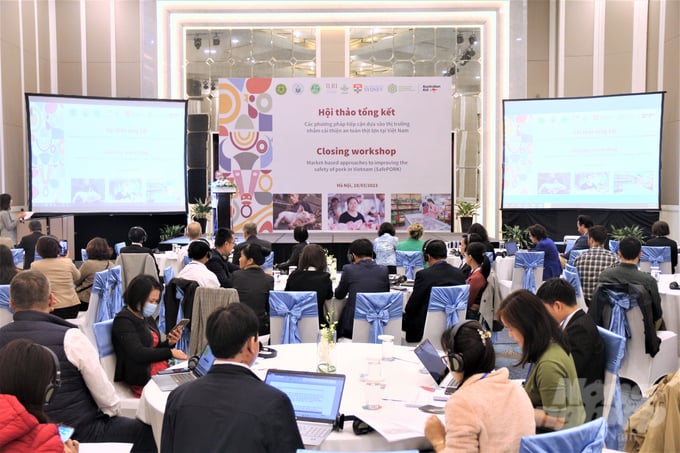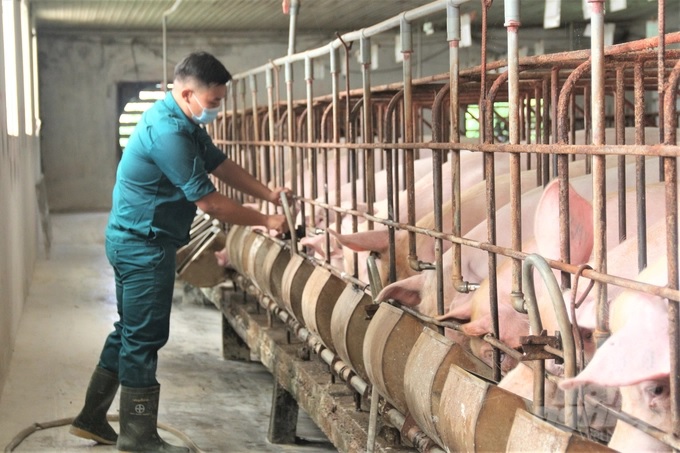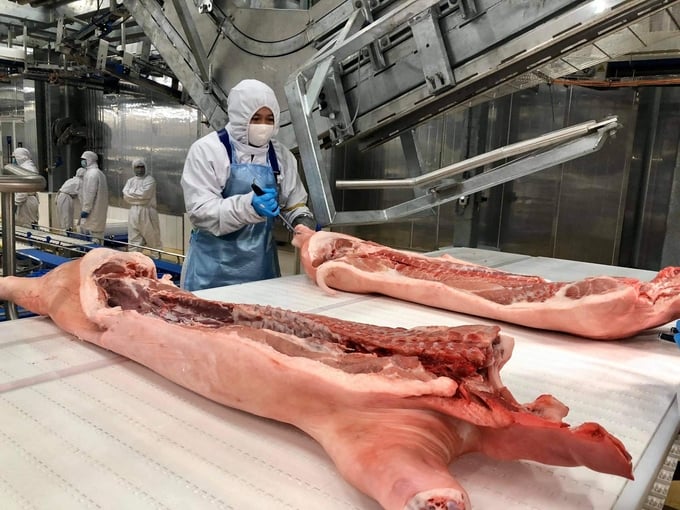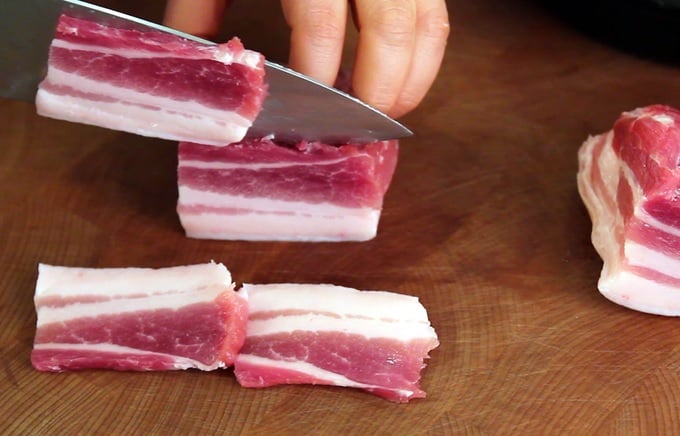November 27, 2025 | 18:12 GMT +7
November 27, 2025 | 18:12 GMT +7
Hotline: 0913.378.918
November 27, 2025 | 18:12 GMT +7
Hotline: 0913.378.918

The workshop "Market-based approaches to improving pork safety in Vietnam" (SafePORK project). Photo: Pham Hieu.
At the Final Workshop of the Project "Market-based approaches to improving the safety of pork in Vietnam (SafePORK)" on March 28, Dr. Pham Duc Phuc, a project member from the Hanoi University of Public Health, said, "Pork is the most consumed meat in Vietnam and the level of Salmonella infection is very high. On average, 1-2 people are at risk of contracting Salmonella from pork yearly".
Salmonella is a common foodborne illness. Most cases are mild, but the disease can become severe and affect anyone. Those most at risk are children under 5, elderly people of 65 years old and more, pregnant women, and people with health issues.
Dr. Fred Unger, the regional representative for the International Livestock Research Institute (ILRI) in East and Southeast Asia, said SafePORK's interventions aim to reduce microbial contamination in pork at the traditional retail market. After the intervention, the Salmonella infection rate in retail pork decreased from 52% to 24%.
“To reduce the burden of foodborne illness in informal, emerging, and niche markets, the SafePORK Project has developed and evaluated simple interventions to improve safety food while protecting the livelihoods of actors in the smallholder pork chain in Vietnam," said Dr. Fred Unger.

Pork is the most consumed meat in Vietnam. Photo: Pham HIeu.
The SafePORK Project has also implemented several simple interventions and capacity-building support to help reduce the primary pathogen Salmonella. Accordingly, the Project's research team surveyed small-scale pork value chain participants. From there, it was determined that the leading causes of unsafe pork were poor hygiene, improper preservation and processing, long meat transportation time, epidemic diseases, pork of unknown origin, and poor quality input.
At the Workshop, the team introduced an intervention package to improve hygiene practices that included separating raw pork, cooked pork, and offal and regularly cleaning the seller's surfaces, equipment, and hands.

Consumers are willing to pay 20% more for safe pork. Photo: Pham Hieu.
An intervention package was also introduced at the abattoirs, which included using stainless steel sheets to prevent carcasses from contacting the floor, frequent hand and surface washing, and better separation of clean and dirty to reduce carcass contamination. The workshop also discussed lessons learned and future directions, recommendations, lessons, opportunities for scaling up, and the potential for further research in the future.
The results of studies by the SafePORK Project show that consumers are willing to pay 20% more for safer pork than for products currently on the market. Specifically, consumers' confidence in the effectiveness of the interventions and the quality of pork at the intervention counters by the Project has increased their willingness to pay for quality and safe pork.
Thereby, the potential economic benefits of upgrading pork stalls can be seen. That will be an essential motivation to push sellers to improve food safety conditions; strengthen training and training on food safety; while upgrading the value chain regarding product and food safety.

Improving the quality and safety of pork is one aspect of upgrading the pork value chain. Meanwhile, concerns about contaminated pork had a negative impact on consumers' willingness to pay for conventional pork. Photo: Pham HIeu.
According to Mr. Nguyen Viet Hung, co-leader of ILRI's Animal-Human Health Program and leader of the One Health initiative of the Consultative Group of International Agricultural Research Organizations (CGIAR), the SafePORK Project shows that simple and low-cost interventions can reduce the level of pork contamination in traditional markets, thereby solving a significant food safety problem.
“We are working with other programs, such as CGIAR’s One Health Initiative, to replicate this positive research result for the benefit of communities in other localities in Vietnam,” said Mr. Nguyen Viet Hung.
Also, according to Dr. Shirley Tarawali, Acting Director of ILRI, SafePORK Project studies and interventions have significantly improved pork safety in Vietnam while supporting many livelihoods. Valuable lessons from this Project will help move towards a safer food system for Vietnam.

The SafePORK project can provide policymakers and the public with scientific evidence which can support possible policy options for more effective food safety management. Photo: Pham Hieu.
The SafePORK project, funded by the Australian Center for International Agricultural Research (ACIAR), will run from 2017 to 2023 in Hanoi, Hung Yen, Nghe An, Thai Nguyen, and Hoa Binh provinces. The International Livestock Research Institute (ILRI), in collaboration with the Hanoi University of Public Health (HUPH), Vietnam National University of Agriculture (VNUA), National Institute of Animal Science (NIAS), and the University of Sydney, Australia, jointly implemented the Project.
The Project aims to help reduce the burden of foodborne illness in informal, emerging, and niche markets. Food safety is improved through simple, market-based approaches that enhance pork hygiene for consumers while protecting the livelihoods of different actors in the pork value chain.
Translated by Ha Phuc
/2025/11/27/3830-1-152901_403.jpg)
(VAN) Dong Nai is developing its key crop areas, expanding planting area codes, and applying high technology to increase the value of agricultural products, aiming at a green and sustainable agriculture.

(VAN) Tay Ninh’s livestock sector is undergoing a major transformation, applying high-tech, closed-loop circular models to build sustainable value chains.
/2025/11/26/3627-4-082628_818.jpg)
(VAN) From a small café on the red basalt highlands, Le Van Hoang started a business with clean coffee, building Enjoi Coffee into a symbol of organic agriculture in the Lam Dong plateau.
/2025/11/25/0045-1-135246_13.jpg)
(VAN) Ca Mau is researching a model of sea-encroaching embankments combined with viaducts and logistics service zones, aiming both to prevent erosion and create land funds for marine economic development.

(VAN) The information was shared at the seminar 'Urban Agriculture - Solutions for Developing Green Spaces,' organized by the Kinh te & Do thi Newspaper and the Biotechnology Center of Ho Chi Minh City.
/2025/11/19/4141-2-132831_216.jpg)
(VAN) One of Japfa's outstanding solutions is implementing digital transformation and artificial intelligence (AI) to optimize operations, enhance productivity, and advance sustainable development.
/2025/11/19/4847-1-093540_448.jpg)
(VAN) The Gia Lai Provincial People’s Committee had a working session with the delegation of the U.S. Department of Agriculture, the State of Idaho, and representatives of the State's leading enterprises.